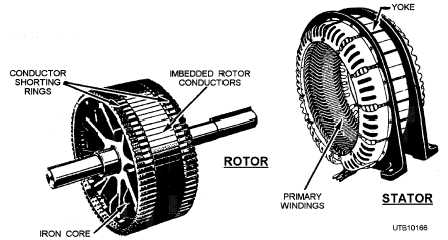due largely to its reliability and simplicity of construction. The basic induction motor has two main assemblies or components-a ROTOR and a STATOR, as shown in figure 6-1. The mechanical rotation of the rotor is produced through the principle of electromagnetic induction. Alternating current flows through the stator (a circular assembly of stationary coils or windings) which surrounds the rotor. The alternating current flow in the stator produces a constantly rotating magnetic field. This magnetic field induces a current flow in the conductors of the rotor (a cylindrical or drumlike assembly of copper bars mounted on a shaft). The induced current in the rotor then produces a magnetic field of its own. The magnetic field of the rotor is produced so it opposes the magnetic field of the stator; that is, the two fields repel each other. This continuous repulsion of the rotor field by the stator field results in a continuous rotation of the rotor assembly around its axis or shaft. Thus electrical rotation (in the stator) is transformed into mechanical rotation (in the rotor).
The rotational speed of the stator field remains constant unless the frequency of the electrical power source varies. The rotational speed of the rotor is also constant and is more or less independent of the workload imposed on it. This is not to say, however, that an induction motor cannot be overloaded. Under heavy or excessive loads, the motor tends to draw more current to maintain speed; this can result in over- heating and burned-out windings.
Induction motors are usually named by the method used for starting the motor. Two fairly common types designed to operate on single-phase current. Induction motors require two or more out-of-time-phase currents to produce the continuously rotating magnetic field in the stator. For this reason, induction motors that must run on a single-phase power supply are provided with split-phase windings that make two phases of the single-phase current. Split-phase motors can be used to drive a variety of equipment, such as washing machines, oil burners, small pumps, and blowers. The capacitor-start induction motor is a variation of the split-phase motor, but it has a high capacity, electrolytic capacitor. The primary function of this device is the storage of to provide more power during the start.
There are a number of mechanical modifications to induction motors. The most important are as follows: (1) the splashproof motor; (2) the totally enclosed, fan- cooled motor; and (3) the explosionproof motor.
The splashproof motor is constructed so dripping or splashing liquids cannot enter the motor. The motor is self-ventilated; but, since moisture-saturated air may be circulated through the motor, the windings are made moisture-resistant. Motors of this type are most often used to drive pumps and other machinery where the moisture content of the air is high.
The totally enclosed, fan-cooled motor has totally enclosed windings and rotor. Cooling air is circulated over the enclosure to remove heat. This motor is used in locations where the surrounding air may contain a high proportion of dust, as in a carpenter shop.
The explosionproof motor is similar to the totally of induction motors, classified in this manner, are the enclosed fan-cooled motor; but, it is constructed to SPLIT-PHASE MOTOR and the CAPACITOR- prevent any explosion within the motor from igniting START MOTOR. Split-phase induction motors are combustible gases or dust in the surrounding air. This

Figure 6-1. - Rotor and stator assemblies of an induction motor.
Continue Reading